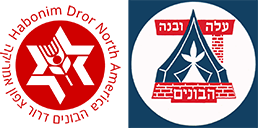BUILDING PROGRESSIVE ZI.ONIST ACTIVISTS
Exploring the Impact of Habonim Dror
A Study by Steven M. Cohen & Steven Fink, 2013
Jewish Background: Many Conservative-Raised & Day School Alumni
Habonim Dror alumni report evidence of childhood Jewish socialization somewhat more intense than that reported by American Jews generally, and on par with that reported by those who attended Jewish camps. About a third of them, in fact, attended or worked in a Jewish camp other than their Habonim Dror camp experience. Almost two thirds participated in Hillel or another campus Jewish organization and as many as 20% served as a leader at some point – both numbers that exceed those reported in other studies.
Table 5. While growing up, in which Jewish denomination, if any, were you raised? (percent)
Further evidence can be seen in their denominational background, as almost half were raised in Conservative homes, and another 8% reported Orthodox upbringing (see Table 5).
|
Denomination |
Habonim Dror Alumni |
NY Comparison Group |
|
Orthodox |
8 |
20 |
|
Conservative |
49 |
36 |
|
Reform |
15 |
28 |
|
Reconstructionist |
5 |
-- |
|
Other movement such as Renewal, Secular Humanist, etc. |
1 |
-- |
|
Just Jewish |
4 |
-- |
|
Not raised Jewish |
0 |
-- |
|
Other |
4 |
-- |
|
Secular Zionist |
6 |
-- |
|
Culturally Jewish |
8 |
-- |
|
Other than O, C, R (NY) |
(28) |
17 |
|
Total |
100 |
100 |
SOURCE: Habonim Dror Survey, 2013
By way of a very approximate comparison, we may examine a segment of respondents drawn from the 2011 Jewish Community Study of New York (Westchester, New York City, and Long Island), constructed to loosely resemble the Habos. The constructed New York sub-sample shares the following characteristics: all are US-born former participants in a Jewish camp, but they contain no current Haredim (ultra-Orthodox Jews) and those who attend religious services more than weekly (almost all of whom are highly committed Modern Orthodox men). In comparison with these former overnight Jewish campers in the eight-county New York area, the Habonim Dror distributions suggest mixed levels of religious traditionalism.
To elaborate … In the New York sample sub-group, far more ex-campers were raised Orthodox (20% vs. 8%), the most observant denomination, and, at the same time, far more were also raised Reform (28% vs. 15%), the least observant denomination. In contrast, the Habos derived significantly more from Conservative background (49% vs. 36%), as well as from “other” origins, that is, not from one of the three largest movements (although the difference in question wording may have contributed to this seeming variation). In any event, the Habonim Dror sample reports an uncharacteristically high number of Reconstructionist parents (5%), judged high by virtue of their numbers in American Jewry that generally place them at around 1%.
The bottom line: The denominational data suggest that Habonim Dror alumni derive from homes that were not necessarily, as a group, more (or less) “religious” or ritually observant than the non-Haredi New York area Jewish camp alumni; but the Habos’ parents’ homes may well have been characterized by stronger Jewish ethnic connections and commitment, as demonstrated by the seemingly high numbers of Conservative and Reconstructionist parents. (To be sure, the point rests on weak evidence, but is consistent both with the Habonim Dror ethos and with the distinctive denominational patterns above.)
The distribution of Jewish schooling experiences also testifies to a stronger than average Jewish upbringing, as fully a quarter reported having attended Jewish day school, just 9% had no Jewish schooling and half reported Jewish supplementary school that met at least twice a week (as do almost all Conservative Hebrew schools) (see Table 6).
|
Jewish schooling |
Habonim Dror Alumni |
NY Comparison Group |
|
None |
9 |
25 |
|
A part-time school that met once a week |
16 |
29 |
|
A part-time school that met 2+times week |
50 |
33 |
|
A Jewish day school or yeshiva |
25 |
23 |
|
Total |
100 |
100 |
SOURCE: Habonim Dror Survey, 2013
For this sub-sample, almost a quarter (23%) attended day school, much like the Habonim Dror alumni. However, in all other respects, Habonim Dror alumni appear to have experienced more intensive Jewish education than comparable New Yorkers. Specifically, the former report more frequent attendance at two+ day-a-week Hebrew schools (50% vs. 33%), while far fewer Habos never stepped foot inside a Jewish classroom (9% vs. 25%).
The schooling patterns are critical not so much for what they say about the intensity of Jewish schooling per se. Rather, they suggest that the homes and communities where Habonim Dror alumni grew up were moderately more connected to Jewish life than were comparable alumni of Jewish camps in the New York area. Moreover, the nature of that connection may be loosely termed as highly “ethnic” rather than highly observant in traditional religious terms.
